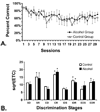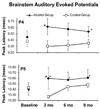Chronic alcohol consumption impairs visuo-spatial associative memory in periadolescent rhesus monkeys
- PMID: 20951512
- PMCID: PMC3024459
- DOI: 10.1016/j.drugalcdep.2010.09.002
Chronic alcohol consumption impairs visuo-spatial associative memory in periadolescent rhesus monkeys
Abstract
Alcohol abuse in the adult is often preceded by high alcohol consumption during adolescence. Profound changes in brain structure and function occur during this developmental period, therefore alcohol may impact essential cognitive skill development during the formal educational years. The objective of this study was to determine if chronic oral alcohol intake slows acquisition and performance of cognitive tasks in male adolescent rhesus monkeys. Treatment groups (Alcohol, N=4; Control, N=3) were evaluated on bimanual dexterity and tests of visuo-spatial memory and learning adapted from the Cambridge Neuropsychological Test Automated Battery. Animals were trained daily in 30 min sessions and had subsequent access to alcohol/Tang® solutions (Alcohol group) or Tang® only (Control group) Monday through Friday for 11 months. Recordings of brainstem auditory evoked potentials (BSAEP) were conducted periodically before and during the chronic drinking.
Results: Chronic alcohol drinking (ave of 1.78 g/kg alcohol per session) impaired behavioral performance assessed ∼22 h after the prior drinking session. The Alcohol group required more trials than the Control group to reach criterion on the visuo-spatial memory task and showed increased sensitivity to trial difficulty and retention interval. Alcohol animals also had slowed initial acquisition of the bimanual task. The latency of P4 and P5 BSAEP peaks were also delayed in the Alcohol group. Chronic alcohol consumption impaired the acquisition and performance of a spatial memory task and disrupted brainstem auditory processing, thus these results show that repeated alcohol exposure in adolescence interferes with a range of brain functions including complex visuo-spatial mnemonic processing.
Copyright © 2010 Elsevier Ireland Ltd. All rights reserved.
Figures







Similar articles
-
Chronic periadolescent alcohol consumption produces persistent cognitive deficits in rhesus macaques.Neuropharmacology. 2014 Nov;86:78-87. doi: 10.1016/j.neuropharm.2014.07.003. Epub 2014 Jul 10. Neuropharmacology. 2014. PMID: 25018042 Free PMC article.
-
Δ⁹Tetrahydrocannabinol impairs visuo-spatial associative learning and spatial working memory in rhesus macaques.J Psychopharmacol. 2012 Oct;26(10):1299-306. doi: 10.1177/0269881112443743. Epub 2012 Apr 22. J Psychopharmacol. 2012. PMID: 22526684 Free PMC article.
-
Modeling a task that is sensitive to dementia of the Alzheimer's type: individual differences in acquisition of a visuo-spatial paired-associate learning task in rhesus monkeys.Behav Brain Res. 2004 Mar 2;149(2):123-33. doi: 10.1016/s0166-4328(03)00214-6. Behav Brain Res. 2004. PMID: 15129776
-
Acute and chronic ethanol intake: effects on spatial and non-spatial memory in rats.Alcohol. 2012 Dec;46(8):757-62. doi: 10.1016/j.alcohol.2012.08.001. Epub 2012 Sep 1. Alcohol. 2012. PMID: 22944615
-
Persistent negative effects of alcohol drinking on aspects of novelty-directed behavior in male rhesus macaques.Alcohol. 2017 Sep;63:19-26. doi: 10.1016/j.alcohol.2017.03.002. Epub 2017 Jun 23. Alcohol. 2017. PMID: 28847378 Free PMC article.
Cited by
-
Behavioral Flexibility in Alcohol-Drinking Monkeys: The Morning After.Alcohol Clin Exp Res. 2020 Mar;44(3):729-737. doi: 10.1111/acer.14289. Epub 2020 Feb 18. Alcohol Clin Exp Res. 2020. PMID: 31984521 Free PMC article.
-
Δ(9)Tetrahydrocannabinol impairs reversal learning but not extra-dimensional shifts in rhesus macaques.Neuroscience. 2013 Apr 3;235:51-8. doi: 10.1016/j.neuroscience.2013.01.018. Epub 2013 Jan 16. Neuroscience. 2013. PMID: 23333671 Free PMC article.
-
Chronic periadolescent alcohol consumption produces persistent cognitive deficits in rhesus macaques.Neuropharmacology. 2014 Nov;86:78-87. doi: 10.1016/j.neuropharm.2014.07.003. Epub 2014 Jul 10. Neuropharmacology. 2014. PMID: 25018042 Free PMC article.
-
Cannabidiol attenuates deficits of visuospatial associative memory induced by Δ(9) tetrahydrocannabinol.Br J Pharmacol. 2013 Dec;170(7):1365-73. doi: 10.1111/bph.12199. Br J Pharmacol. 2013. PMID: 23550724 Free PMC article.
-
Δ⁹Tetrahydrocannabinol impairs visuo-spatial associative learning and spatial working memory in rhesus macaques.J Psychopharmacol. 2012 Oct;26(10):1299-306. doi: 10.1177/0269881112443743. Epub 2012 Apr 22. J Psychopharmacol. 2012. PMID: 22526684 Free PMC article.
References
-
- Bauer RH, Fuster JM. Delayed-matching and delayed-response deficit from cooling dorsolateral prefrontal cortex in monkeys. J. Comp. Physiol. Psychol. 1976;90:293–302. - PubMed
-
- Begleiter H, Porjesz B, Bihari B, Kissin B. Event-related brain potentials in boys at risk for alcoholism. Science. 1984;225:1493–1496. - PubMed
-
- Blokland A, Prickaerts J, Raaijmakers W. Absence of impairments in spatial and temporal discrimination learning in Lewis rats after chronic ethanol consumption. Pharmacol Biochem Behav. 1993;46:27–34. - PubMed
-
- Brown SA, Tapert SF, Granholm E, Delis DC. Neurocognitive functioning of adolescents: effects of protracted alcohol use. Alcohol Clin Exp Res. 2000;24:164–171. - PubMed
Publication types
MeSH terms
Substances
Grants and funding
LinkOut - more resources
Full Text Sources
Medical
Miscellaneous

